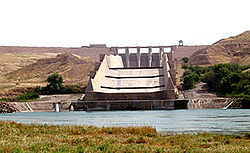Dams and barrages in Iraq (clickable map)
The following is a list of dams and reservoirs in Iraq. They are sorted according to their location in either the Euphrates or the Tigris river basin.
The following is a list of dams and reservoirs in Iraq. They are sorted according to their location in either the Euphrates or the Tigris river basin.
